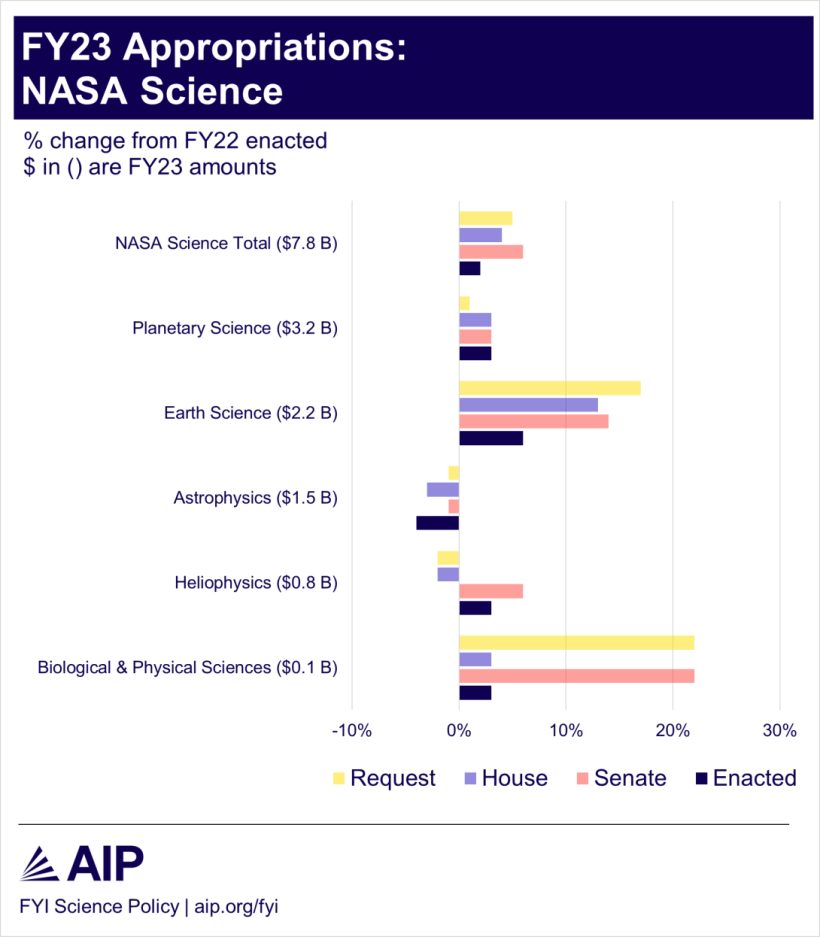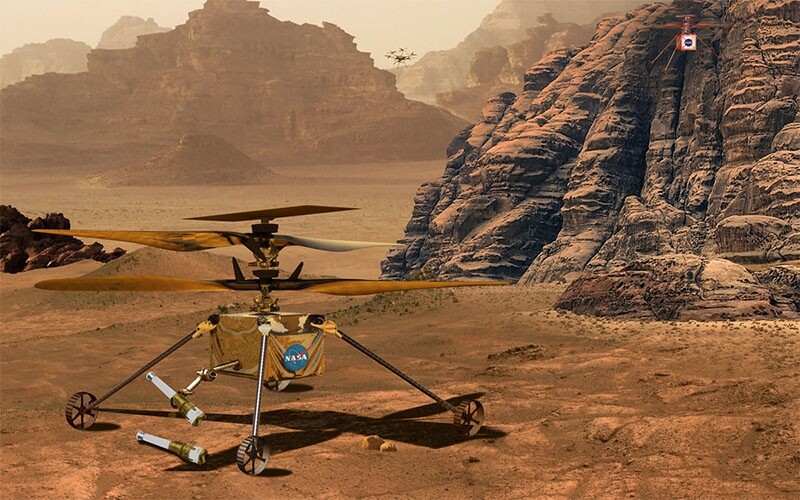
FY23 Budget Outcomes: NASA
The budget for NASA’s Science Mission Directorate rose 2% in fiscal year 2023 to $7.8 billion, a small percentagewise increase compared to what other parts of NASA and other federal science agencies
Congress acceded this year to NASA’s decision to cease operating the SOFIA airborne telescope, having previously protected it from proposals to shut it down. However, lawmakers did not allocate SOFIA’s operating budget to other activities in the Astrophysics Division, which saw its topline budget cut by 4%. Other science divisions received modest increases and Congress generally met the budgets requested for major projects, but strains on resources are being felt across the directorate.
Congress provided detailed direction for NASA in an explanatory statement


Planetary Science
The Planetary Science Division budget increased 3% to $3.20 billion, roughly double its fiscal year 2016 level. Rising funding has allowed the division to vastly expand its activities in lunar science and develop missions aimed at defending the Earth from asteroids. It has also supported an increasingly ambitious portfolio of robotic missions to destinations across the Solar System. However, these obligations are pushing against the limits of even the expanded budgets Congress has provided.
Mars Sample Return. NASA’s budget for the flagship MSR mission increased from $653 million to no less than the requested level of $822 million. NASA has been devoting extensive resources to the project during its early formulation. Over the past year, NASA announced two redesigns of the mission, which now aims to launch its sample retrieval component in 2028 rather than 2026 and will no longer include a rover that was to have been supplied by project partner, the European Space Agency. Instead, MSR will rely on

A concept illustration for a helicopter to be included on the Mars Sample Return mission. A more advanced science helicopter concept is shown in the background, while the currently operating Ingenuity helicopter is depicted in the upper-right corner. (Image credit – NASA / JPL-Caltech)
Europa Clipper and Titan Dragonfly. The annual budget for NASA’s multiple-flyby mission to Jupiter’s moon Europa decreased as planned from $472 million to $345 million as it approaches its October 2024 launch date. That places the flagship mission’s share of the division budget behind the Dragonfly rotorcraft mission to Saturn’s moon Titan, which is part of the medium-scale New Frontiers portfolio. Aiming to launch in 2027, Dragonfly’s budget increased from $219 to at least $400 million this year, which is $10 million more than requested.
Other New Frontiers missions. The overall New Frontiers budget increased from $284 million to $478 million, as requested. Of the portion not going to Dragonfly, the OSIRIS-REx mission’s share is larger this year to accommodate delivery of its sample from the asteroid Bennu and the spacecraft’s transition to a newly approved
Discovery missions. Congress did not specify a funding level for the Discovery program, which NASA planned to ramp down from $332 million to $230 million during an anticipated lull in activity this year. However, the program is now in flux due to the Psyche asteroid mission missing its first launch window
Planetary defense. The planetary defense budget fell from $166 million to $138 million, partially owing to the launch and successful conclusion
Lunar science missions. Congress allocated up to $486 million for the Lunar Discovery and Exploration program, close to its previous budget level. The first missions in the Commercial Lunar Payload Services (CLPS) program have been repeatedly delayed, with three now scheduled to launch this year, but the program’s fixed-cost contracting model means that contractors bear the costs of any delays they are responsible for. This year’s budget for the NASA-built Volatiles Investigating Polar Exploration Rover (VIPER) is $97 million. Last summer, the agency delayed VIPER’s target launch date by one year to late 2024 because it decided to require additional testing
Earth Science
Congress raised the Earth Science Division’s budget by 6% to $2.2 billion, which was the largest proportional increase for any of NASA’s science divisions but still short of the $2.41 billion requested. A senior division official indicated last month, just before the budget was finalized, that funding limitations are making it difficult
Earth System Observatory. Much of the pressure on the division’s budget arises from the increasing needs of the Earth System Observatory satellite series that NASA is planning to start launching later this decade. NASA aimed to increase the missions’ budget from $100 million to $212 million for this year. Congress did not specify a budget level for them but broadly directed NASA to submit budget plans for each of the satellites individually in future budget requests. Congress also directed NASA to “plan to competitively select future missions,” without further elaboration. Because the Earth System Observatory is classified as a strategic initiative, NASA assigned development of the satellites to JPL and the Goddard Space Flight Center without a competitive process, but it does plan to hold competitions for development of many of the satellites’ instruments.
GeoCarb. In November, NASA decided to cancel
Wildfire detection. Congress allocated $8 million to “initiate concept studies to develop and demonstrate low-cost and scalable infrared sensing and other technologies for wildfire management,” and specifies the money is on top of funds NASA requested for other wildfire research activities.
Astrophysics

The primary mirror of the Nancy Grace Roman Space Telescope. (Image credit – Chris Gunn / NASA)
NASA astrophysics head Mark Clampin remarked
Roman Space Telescope. Driving toward a 2027 target launch date, the budget for the Nancy Grace Roman Space Telescope is decreasing as planned from $502 million to $482 million, with Congress continuing to cap the flagship mission’s development cost at $3.5 billion. Work is proceeding apace
Webb Space Telescope. Now fully engaged in science operations, the budget for the flagship James Webb Space Telescope is remaining steady at $173 million.
SOFIA. Congress allocated at least $30 million to close out operations of the Stratospheric Observatory for Infrared Astronomy, triple NASA’s proposal. NASA terminated SOFIA’s operations in September citing its modest scientific output relative to its $85 million annual operating budget, which placed it among the most expensive science missions the agency was operating. SOFIA will now reside permanently
Heliophysics
Congress increased the Heliophysics Division budget by 3% to $805 million, turning back a requested 2% cut.
Solar Terrestrial Probes. The budget for the Solar Terrestrial Probes program dropped from $234 million to $208 million rather than the $189 million requested. Congress allocated $5 million of the additional funding to early work on the Dynamic Neutral Atmosphere Ionosphere Coupling (DYNAMIC) mission, which NASA had delayed
Geospace Dynamics Constellation. The annual budget for GDC rose to $73 million, $10 million more than requested. This month, NASA finished selecting
Other programs

NASA’s Orion crew vehicle passing the Moon during the Artemis I mission in December 2022. (Image credit – NASA)
Artemis. Congress provided amounts matching or close to those requested for various elements of the Artemis lunar exploration campaign, including $2.6 billion for the Space Launch System rocket program, $1.34 billion for the Orion crew vehicle program, and $1.49 billion for the crewed lunar lander program. Though long delayed and well overbudget
Nuclear technology. Congress provided level funding of $110 million for developing nuclear thermal propulsion (NTP) systems. NASA has just announced it is pooling its efforts
Biological and Physical Science. The budget for the program that supports scientific experiments on the International Space Station and other platforms rose 3% to $85 million, well short of the $100 million requested. However, Congress did express support for the program’s new strategy of focusing its efforts in priority areas such as quantum physics, soft matter, and human physiology in deep space. In light of the shortfall, NASA has put off plans
Aeronautics. The budget for NASA’s Aeronautics Research Mission Directorate rose 6% to $935 million. The Biden administration had sought a 10% increase, in part to ramp up efforts in sustainable aviation and electrified powertrains. This month, NASA awarded
STEM Engagement. The budget for NASA’s Office of STEM Education increased 5% to $144 million. The office oversees the agency’s Space Grant and EPSCoR programs, Minority University Research and Education Project, and Next Generation STEM Project.


